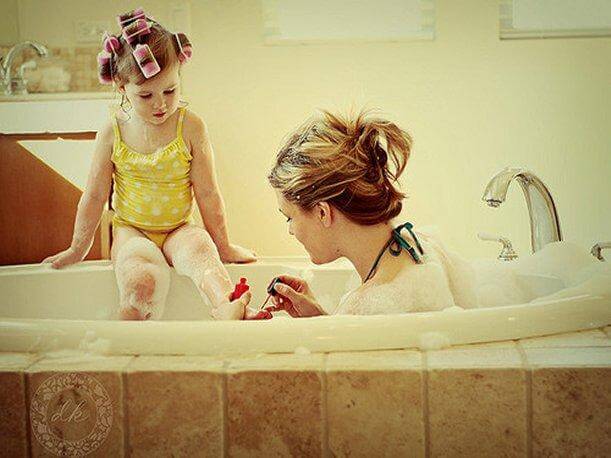13 Ways to Show Your Child How Much You Love Them

In this article we’ll share 13 ways to show your child how much you love them and why the love between “mother and child” will always be mutual and unconditional.
The love a mother has for a child is immeasurable and it may be hard to quantify but don’t worry, mom: We’ll explain a few simple ways to show your child how much you love them.
From the moment we have our baby in the womb, we have the wonderful ability and gift to give them our most sublime and tender lover.
This newfound love and desire can be seen in how we plan for a new life with our child, for example when:
- We perform our prenatal checkups on time.
- We decorate the child’s room.
- Parents buy the things the child will need when they’re born (stroller, cradle, baby carrier, bathtub, clothes and accessories).
- We imagine and daydream about them for hours on end, and show whoever passes by our side an ultrasound image.
- We perform intrauterine stimulation (reading, caressing the belly, singing and talking to the baby, etc.).
Once the baby is in our arms it’s possible to express how much we love them in different ways. For example, when we feed, groom, protect and continue carrying out various stimulation exercises.
To you beloved mother,
the first person I named
with a love without dimensions,
you taught me to talk and walk too
-Daniela Aragunde-
13 ways to show your child how much you love them

Your love for a child has no limits, every step that a mother takes will always be in their child’s favor. These steps even include scolding and correcting behavior at certain times.
Children, however, sometimes have trouble noticing and realizing all the love we feel for them.
That’s why we’re providing these 13 ways to show your child how much you love and value them:
- Saying good morning to them as they wake up. Phrases such as: I love you, I miss you, and speaking to them in a respectful way lets them know how important they are to you and the family.
- Maintaining frequent physical contact with caresses, kisses and hugs. Let the child know that you trust them whenever you can.
- Learning the names of their favorite animated characters and identifying special songs to heal their wounds, falls or any sort of pain.
- Being humble and asking for forgiveness when you’re wrong
- Telling stories, reading books or sharing anecdotes about when you were little.
- Leading by example. Be their role model, maintain your image as an honest, hardworking, patient and respectful parent.
- Dedicating quality time. Even though they change their interests, you’ll never stop spending time with them.
- Establishing rules to discipline and facilitating their integration in society.
- Motivating them constantly to achieve their goals no matter how small or significant they may be. It is important for them to understand that their goals can be achieved with effort and perseverance.
- Sharing experiences with them such as: traveling, playing and singing. These are excellent ways to show them how much you love and care for them.
- Getting involved in their school work and communicating with their teachers frequently in order to resolve any weaknesses they may have.
- Reciprocate their feelings. Leave what you’re doing when they offer you a loving gesture and don’t forget to thank them affectionately. Show them your unconditional love by supporting them in the face of difficulties or when they’re sick.
- Saying goodnight before they go to bed. Give the child a tender kiss on the cheek or forehead.
Reciprocal love

Children have the ability to form strong bonds with anyone who is able to respond to their physical and emotional needs. These bonds are often complete and in-depth with the people who provide support, security and love.
Showing your child how much you love and value them can make it easier for them to understand the different ways they can give and receive love.
Remember: there is no love that is more intense and reciprocal than the love between mother and child.
The connection between a mother and her child is established and solidified on a base of constant interaction and mutual love.
This love forms one of the strongest and most intense relationships that exists in nature: “love between mother and child” – an irreplaceable, necessary and lasting love.
Thanks mom, I thought you were a superhero as a child. But now that I’ve grown up, I realize that you really are.
-Anonymous-
In this article we’ll share 13 ways to show your child how much you love them and why the love between “mother and child” will always be mutual and unconditional.
The love a mother has for a child is immeasurable and it may be hard to quantify but don’t worry, mom: We’ll explain a few simple ways to show your child how much you love them.
From the moment we have our baby in the womb, we have the wonderful ability and gift to give them our most sublime and tender lover.
This newfound love and desire can be seen in how we plan for a new life with our child, for example when:
- We perform our prenatal checkups on time.
- We decorate the child’s room.
- Parents buy the things the child will need when they’re born (stroller, cradle, baby carrier, bathtub, clothes and accessories).
- We imagine and daydream about them for hours on end, and show whoever passes by our side an ultrasound image.
- We perform intrauterine stimulation (reading, caressing the belly, singing and talking to the baby, etc.).
Once the baby is in our arms it’s possible to express how much we love them in different ways. For example, when we feed, groom, protect and continue carrying out various stimulation exercises.
To you beloved mother,
the first person I named
with a love without dimensions,
you taught me to talk and walk too
-Daniela Aragunde-
13 ways to show your child how much you love them

Your love for a child has no limits, every step that a mother takes will always be in their child’s favor. These steps even include scolding and correcting behavior at certain times.
Children, however, sometimes have trouble noticing and realizing all the love we feel for them.
That’s why we’re providing these 13 ways to show your child how much you love and value them:
- Saying good morning to them as they wake up. Phrases such as: I love you, I miss you, and speaking to them in a respectful way lets them know how important they are to you and the family.
- Maintaining frequent physical contact with caresses, kisses and hugs. Let the child know that you trust them whenever you can.
- Learning the names of their favorite animated characters and identifying special songs to heal their wounds, falls or any sort of pain.
- Being humble and asking for forgiveness when you’re wrong
- Telling stories, reading books or sharing anecdotes about when you were little.
- Leading by example. Be their role model, maintain your image as an honest, hardworking, patient and respectful parent.
- Dedicating quality time. Even though they change their interests, you’ll never stop spending time with them.
- Establishing rules to discipline and facilitating their integration in society.
- Motivating them constantly to achieve their goals no matter how small or significant they may be. It is important for them to understand that their goals can be achieved with effort and perseverance.
- Sharing experiences with them such as: traveling, playing and singing. These are excellent ways to show them how much you love and care for them.
- Getting involved in their school work and communicating with their teachers frequently in order to resolve any weaknesses they may have.
- Reciprocate their feelings. Leave what you’re doing when they offer you a loving gesture and don’t forget to thank them affectionately. Show them your unconditional love by supporting them in the face of difficulties or when they’re sick.
- Saying goodnight before they go to bed. Give the child a tender kiss on the cheek or forehead.
Reciprocal love

Children have the ability to form strong bonds with anyone who is able to respond to their physical and emotional needs. These bonds are often complete and in-depth with the people who provide support, security and love.
Showing your child how much you love and value them can make it easier for them to understand the different ways they can give and receive love.
Remember: there is no love that is more intense and reciprocal than the love between mother and child.
The connection between a mother and her child is established and solidified on a base of constant interaction and mutual love.
This love forms one of the strongest and most intense relationships that exists in nature: “love between mother and child” – an irreplaceable, necessary and lasting love.
Thanks mom, I thought you were a superhero as a child. But now that I’ve grown up, I realize that you really are.
-Anonymous-
All cited sources were thoroughly reviewed by our team to ensure their quality, reliability, currency, and validity. The bibliography of this article was considered reliable and of academic or scientific accuracy.
- Bowlby, J. (1969). Attachment, Vol. 1 of Attachment and loss. New York: Basic Books.
- Delgado, A. O., & Oliva Delgado, A. (2004). Estado actual de la teoría del apego. Revista de Psiquiatría y Psicología del Niño y del Adolescente, 4(1), 65-81.
- López, C. y Ramírez, M. (2005). Apego. Revista Chilena de Medicina Familiar, 6(1).
- Barudy, J., & Dantagnan, M. (2005). Los buenos tratos a la infancia: Parentalidad, apego y resiliencia. Editorial Gedisa.
- Garrido-Rojas, L. (2006). Apego, emoción y regulación emocional. Implicaciones para la salud. Revista latinoamericana de psicología, 38(3), 493-507. https://www.redalyc.org/pdf/805/80538304.pdf
- Marrone, M., Diamond, N., Juri, L., & Bleichmar, H. (2001). La teoría del apego: un enfoque actual. Madrid: Psimática.
- Mosquera D, Gonzalez, A (2009) Escala de Apego y Patrones Relacionales.
- Mosquera, D., & González, A. (2013). Del apego temprano a los síntomas del trastorno límite de personalidad. Revista Digital de Medicina Psicosomática y Psicoterapia, 3(3), 1-33. http://www.psicociencias.com/pdf_noticias/Apego_y_TLP.pdf
- Shaffer, D. R., & del Barrio Martínez, C. (2002). Desarrollo social y de la personalidad. Madrid: Thomson.
This text is provided for informational purposes only and does not replace consultation with a professional. If in doubt, consult your specialist.








